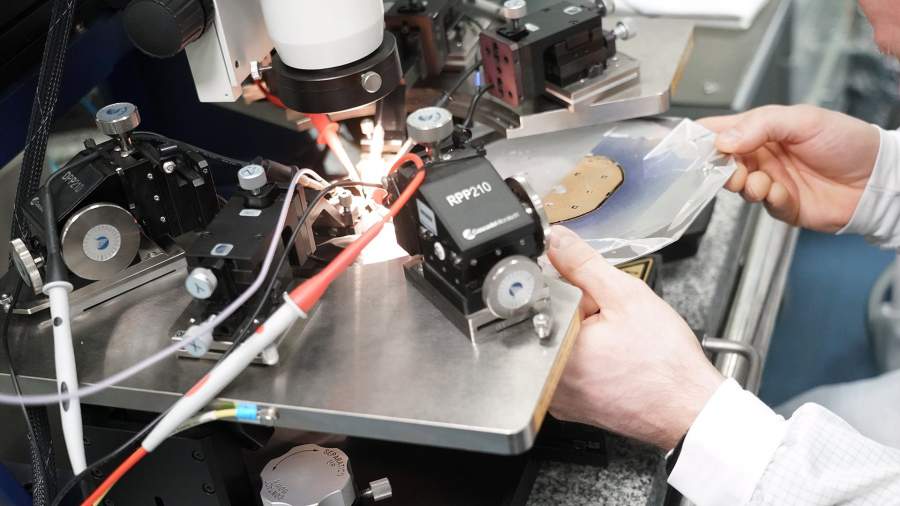
Russia “came out of the shadows”: domestic chips moved into the quantum world
For many years, semiconductors have been the main component driving the growth of entire industries. As the technological race intensifies between the United States and China, Russian developers are improving their own production capabilities. Under sanctions, the country needs chips, and entirely domestic ones. What are Russia's chances of possibily developing a solution to this problem.
Semiconductors, in simple terms, are a special type of material that forms the basis for chips. Semiconductors are used to create diode and transistor elements, as well as microcircuits. Memory chips are used to store and transfer data to parts of a computer. Microprocessors, which are responsible for performing operations written in machine code, are known as the "heart" and "brain" of technology. There are also other integrated circuits that are used for a specific task, such as manufacturing, barcode scanning, Bitcoin mining, and so on.
Semiconductors have been largely overlooked for decades, but have played a pivotal role in the technology sector. Their importance was brought into sharp focus during the coronavirus pandemic, when supply chains were disrupted due to border closures. As Wired magazine observed, the computerisation of almost all processes and areas, from the automotive industry to medicine, has clearly demonstrated the indispensable role of microcircuits in the global economy.
Global chip sales reached an all-time high of $574.1 billion in 2022, but fell 8.2 percent to $526.8 billion in 2023, according to the Semiconductor Industry Association.
At the same time, according to World Semiconductor Trade Statistics (WSTS) reports, growth in the fourth quarter of 2023 showed the best result – 8.4 percent. It is also worth noting that the highest revenue figures were achieved by the American Nvidia ($20 billion), Taiwanese TSMC ($19.67 billion), and South Korean Samsung ($16.4 billion).
According to the Semiconductor Industry Association (SIA) 2023 report, China and the United States are key players in global chip supply chains that are driving industry development and market expansion. Both countries previously announced policies to improve their domestic semiconductor ecosystems, as well as unprecedented investments in semiconductor manufacturing.
As The New York Times reported last year, Washington wants to gain control of advanced computing and semiconductor technologies. As part of this strategy, in the summer of 2023, the US Congress allocated $52 billion to support domestic chip production. America has also tried to eliminate technology rivals by imposing sanctions on Chinese companies in October. They affected 28 Chinese companies, laboratories and research institutes.
Nevertheless, the race to develop semiconductors continued. In February 2024, the Financial Times reported that the Chinese company SMIC had assembled production lines for the mass production of next-generation chips. The publication reports that the 5-nanometer Kirin processors for premium smartphones are being developed by Huawei's HiSilicon division. At the same time, last year SMIC released seven-nanometre chips, which were installed in the Huawei Mate 60 Pro.
Furthermore, in early April, the Turkish newspaper Yeni Şafak reported that the technological rivalry between China and the United States had reached a new level. The United States has taken the decision to blacklist Huawei, which is a partner of SMIC. In response, Beijing will establish the world's largest chip fund and prohibit the use of semiconductors produced by American companies Intel and AMD in government agencies
Alexander Lebedev, academic director of the Master’s programme in Retail Management at the Higher School of Business of the National Research University Higher School of Economics, believes that the technological race between the United States and China could lead to increased innovation in the field of semiconductors, which in turn will affect the global market. He also noted that the Sino-American rivalry is unlikely to affect the cost of electronics, given the significant role logistics plays in the semiconductor market.
Despite the technological leadership of companies from the USA (Intel, AMD, NVIDIA, Qualcomm), Taiwan (TSMC) and South Korea (Samsung Electronics), there are other successful semiconductor manufacturers in the world. For example, the Russian manufacturer Mikron produces billions of chips annually, most of which are exported. This is not widely discussed.
Russia, in the context of Western sanctions pressure, began producing and improving its own chips. In 2023, the Ministry of Industry and Trade allocated 2.2 billion rubles for the development of materials, and Prime Minister Mikhail Mishustin instructed the department to work on the creation of an X-ray lithograph for the production of microcircuits. Representatives of Peter the Great St. Petersburg Polytechnic University (SPbPU), whose specialists came up with the complex, informed RIA Novosti about the appearance of such equipment.
Furthermore, as Deputy Minister of Industry and Trade Vasily Shpak stated at the Microelectronics-2023 forum, the department anticipates mastering the serial production of chips in accordance with 28 nanometre technological standards on 300 mm silicon wafers by 2027.
The key parameter in the semiconductor market is production technology, more precisely the density with which semiconductors are "packed" on the board. This is measured in nanometers, with the most advanced technology now focused on 3 nm. However, as the expert emphasised, it cannot be said that any electronic brain should have precisely such densely packed microcircuits. “It is important to consider the physical limitations of condensing existing technological principles. It seems that the next global technological breakthrough will be based on the principles of quantum computing,” he added.
This year, the team at the scientific and educational centre Functional Micro/Nanosystems (REC FMS) – a joint cluster of MSTU – will be focusing on: N.E. Bauman and the Federal State Unitary Enterprise "VNIIA named after N.L. Dukhov" have developed a technology for manufacturing photonic integrated circuits. The team has also announced the launch of Russia's first mass production of superconducting quantum processors.
In addition, scientists at the Moscow Institute of Physics and Technology have launched Russia's first 12-qubit quantum processor for quantum machine learning based on superconductors.
